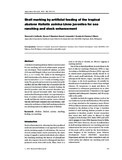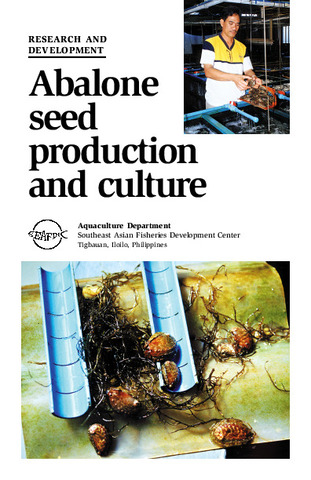Shell marking by artificial feeding of the tropical abalone Haliotis asinina Linne juveniles for sea ranching and stock enhancement
- Global styles
- MLA
- Vancouver
- Elsevier - Harvard
- APA
- Help

View/Open
Date
2003Page views
2,582ASFA keyword
AGROVOC keyword
Taxonomic term
Metadata
Show full item recordCited times in Scopus
- Citations
- CrossRef - Citation Indexes: 19
- Scopus - Citation Indexes: 23
- Captures
- Mendeley - Readers: 20
Share
Abstract
A method of marking abalone (Haliotis asinina Linne) for sea ranching and stock enhancement purposes was developed. Three-month-old abalone juveniles (11.8-mm shell length, 0.28 g) were fed artificial diets for 1, 2, or 3 weeks. The width of the bluish-green shell band produced by abalone juveniles was 1.7, 2.6, and 4.2 mm after 1, 2, or 3 weeks of feeding respectively. The growth and survival of juveniles fed artificial diets did not differ from that of juveniles fed the seaweed Gracilariopsis bailinae (control). Feeding the diet-fed juveniles with the seaweed thereafter produced the natural brownish shell, thus forming a sandwiched bluish-green band. An experimental release in outdoor tanks with natural growth of seaweeds and diatoms, and in a marine reserve showed that the shell band remained clear and distinct, indicating the usefulness of this shell marking method in sea ranching and stock enhancement of abalone.
Suggested Citation
Gallardo, W. G., Bautista-Teruel, M. N., Fermin, A. C., & Marte, C. L. (2003). Shell marking by artificial feeding of the tropical abalone Haliotis asinina Linne juveniles for sea ranching and stock enhancement. Aquaculture Research , 34(10), 839-842. https://doi.org/10.1046/j.1365-2109.2003.00890.x
Type
ArticleISSN
1355-557X; 1365-2109Collections
- Journal Articles [1249]
Related items
Showing items related by title, author, creator and subject.
-
Abalone seed production and culture
Unknown author (Aquaculture Department, Southeast Asian Fisheries Development Center, 2000)Details the research conducted at AQD for the tropical abalone Haliotis asinina. AQD has developed the rudiments of a hatchery protocol. -
Evaluation of post-release behavior, recapture, and growth rates of hatchery-reared abalone Haliotis asinina released in Sagay Marine Reserve, Philippines
Lebata-Ramos, Ma. Junemie Hazel ; Doyola-Solis, Ellen Flor C.; Abrogueña, Jeff Bogart R.; Ogata, Hiroshi; Sumbing, Joemel G.; Sibonga, Rema
; Doyola-Solis, Ellen Flor C.; Abrogueña, Jeff Bogart R.; Ogata, Hiroshi; Sumbing, Joemel G.; Sibonga, Rema  (Taylor & Francis, 2013)
The lucrative returns brought by abalone fisheries have caused overexploitation and decline of the wild population. In the Philippines, the Aquaculture Department of the Southeast Asian Fisheries Development Center has ...
(Taylor & Francis, 2013)
The lucrative returns brought by abalone fisheries have caused overexploitation and decline of the wild population. In the Philippines, the Aquaculture Department of the Southeast Asian Fisheries Development Center has ... -
Evaluation of density and cage design for the nursery and grow-out of the tropical abalone Haliotis asinina Linne 1758
Encena II, Vincent C.; de la Peña, Milagros; Balinas, Vicente T. (National Shellfisheries Association, 2013)The effect of stocking density and cage design on the growth, survival rate, and feed conversion ratio was evaluated for the nursery (11–15 mm in shell length) and juvenile grow-out (26–30 mm in shell length) of the tropical ...






